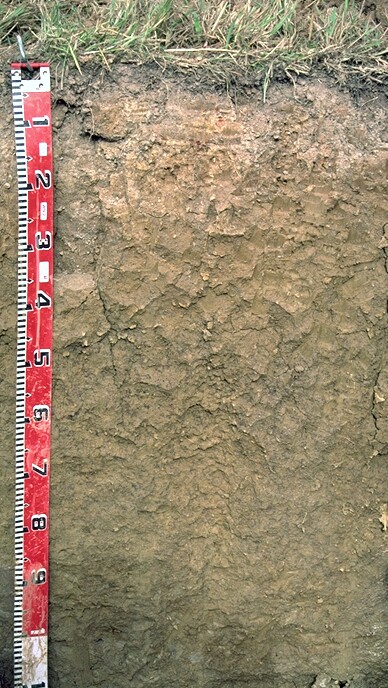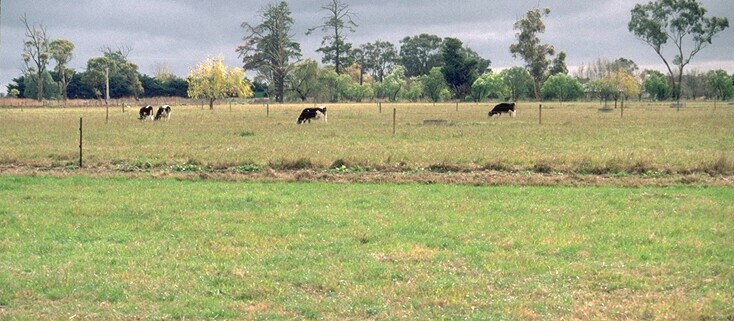GN28
| Property: ISIA Tatura | Australian Soil Classification: Sodic, Hypocalcic, Brown CHROMOSOL |
| Northcote Factual Key: Dy 2.13 | Great Soil Group: red-brown earth (hydromorphic variant) |
| Soil Type: GOULBURN LOAM | |
| General Landscape Description: Level plain with prior stream activity. | |
| ||
Surface Soil
| A11 | 0-5 cm | Dark brown (10YR4/3) loam, fine sandy; abundant plant roots (> 50%); clear change to: |  GN28 Profile |
| A12 | 5-12 cm | Dark yellowish brown (10YR4/4) [sporadically bleached in patches] clay loam; rusty root channel mottling present; weak coarse blocky structure; firm consistence, slightly moist; contains many (20 - 30 %) ferromanganiferous nodules and concretions (5 -10 mm size); rusty root channel mottling present; pH 6.5; abrupt and wavy change to: | |
| Subsoil | |||
| B21 | 12-45 cm | Yellowish brown (10YR5/4 and 5/6) medium clay; moderate coarse blocky structure; strong consistence, slightly moist; contains very few (2 %) manganese stains; pH 7.4; clear change to: | |
| B22 | 45-90 cm | Yellowish brown (10YR5/6 and 6/6) medium clay; moderate coarse blocky, breaking down to moderate fine polyhedral structure; strong consistence, slightly moist; contains few (5-10 %) manganese stains and a trace amount of soft carbonate; pH 7.8; clear change to: | |
| B23 | 90-120 cm | Light olive brown (2.5Y5/4) medium clay; strong fine polyhedral, breaking down to strong very fine polyhedral structure; pH 8.5. | |
Key Profile Features:
- Strong texture contrast between surface (A) horizons and subsoil (B21).
pH | Salinity Rating | |||
Surface soil (A1 horizon) | Slightly Acid | Very Low | Sodic | None |
Upper subsoil (B21 horizon) | Slightly Alkaline | Very Low | Non-Sodic | Moderate1 |
Deep subsoil (at 1 m) | Strongly Alkaline | Very Low | Sodic | - |

Management Considerations:
Surface (A) Horizons
- The surface soil has a high fine sand (36%) and silt (33%) content. Organic matter is important for maintaining soil aggregation for such soils. Reduction in organic matter levels due to cultivation will promote slaking and resultant surface sealing; restricting infiltration and plant emergence.
- The upper subsoil is non-sodic, but does disperse (although not strongly). This may occur due to the high levels of exchangeable magnesium (ie. 39 %) and indicates that some restriction to water and root movement will occur. The presence of rusty root channel mottling in the surface horizon suggests that some restricted drainage occurs in the soil profile. The subsoils of Goulburn loam soils are generally regarded as having poorer drainage characteristics than Lemnos loam subsoils.
Profile described by Mark Imhof and Paul Rampant (4/6/96)


